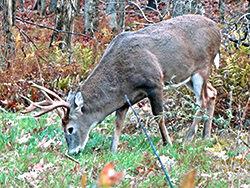Managing White-Tailed Deer: A Conservation Priority
by Charles Smith
 Most residents in the Northern Virginia area understand the need to change human land use practices to stop or minimize habitat destruction and preserve good examples of our native plant communities. Most residents in the Northern Virginia area understand the need to change human land use practices to stop or minimize habitat destruction and preserve good examples of our native plant communities.
An increasing number of people also support combating the spread of non-native invasive species to include problem plant species and insects such as gypsy moth, which can strip tree foliage and cause their death.
These two conservation priorities remain tremendously important, but there is a critical need to add another: controlling populations of white-tailed deer.
Humans arrived in North America over 13,000 years ago. Once our species arrived, we, not wolves and mountain lions, gradually became the top predator controlling populations of large herbivores.
Many of those species eventually went extinct. The white-tailed deer nearly joined their ranks by about 1900, with very few deer left in the state.
In the mid-20th century, Virginia joined many other states in reintroducing white-tailed deer to supplement the few deer left and increase numbers for sport hunting.
From the 1950s through the 1980s two things happened that greatly contributed to the increase in the number of deer. First land use shifted away from agriculture toward suburban and urban uses.
Contrary to commonly held beliefs, suburban landscapes do not take away deer habitat - they create it. Deer are adaptive animals. Suburban development creates preferred edge habitat for deer, and human landscapes provide high concentrations of edible plants close to the ground where the deer can get to them.
You can grow more deer in suburbia than you can in a purely forested landscape.
The second major factor is that few people hunt. Deer are a prey species that requires predation to control their populations. Without predation they can double their numbers in as little as one year.
With almost no hunting pressure in suburban areas and declining hunting pressure in rural areas, deer numbers have skyrocketed state-wide. In many areas of the state, deer population numbers are at more than three to eight times the densities that native plant communities can sustain.
The result is that our remaining forest ecosystems are decimated. Deer eat everything native with few exceptions. They eat almost all of the non-woody plants in the forest as well as all shrubs and trees within their reach and the majority of the acorns and hickory nuts. They have now removed most vegetation from many of our forests below 5 feet.
The results include the disappearance of most of our forest bird species in many areas due to loss of the understory, the loss of many of our woodland wildflowers, and a change of our forest stand composition to a few species such as tulip tree, American beech and red maple that have smaller seeds and appear to be less palatable to deer.
As our forests are oversimplified we lose native species, non-native invasive plants explode and become the dominant understory. Once the existing trees die, there will be little to replace them.
In 2008 the USDA Forest Service began to make dire predictions about eastern forests due to the over-browsing by white-tailed deer. The problem is so severe that even if we could reduce the number of deer immediately to within ecologically sustainable levels, it would take many decades if not centuries to recover our native plant communities.
If we act soon we can retain enough native plant stock and seed that many species could recover within remaining forests and repopulate surrounding areas over time.
It is time for residents and local governments in Northern Virginia to join with USDA Forest Service, the Virginia Natural Heritage Program, large landowners and managers elsewhere in Virginia, the Maryland Native Plant Society and others in supporting and urging efforts to reduce and manage the number of white-tailed deer in order to protect our native plant species, the communities in which they live and the animal species they support.
Charles Smith is a board member of the Prince William Conservation Alliance and Prince William Wildflower Society |